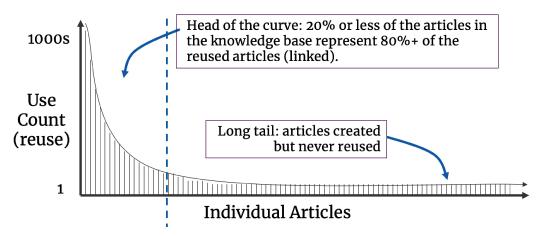KDA Techniques
Overview of Knowledge Domain Analysis Techniques
There are four types of exercises we want to do to identify improvement opportunities and understand the value of a knowledge domain. We'll look at each of these in-depth later in this guide.
Analysis of Frequently Used Articles
Ranking the articles in a domain from the most frequently linked (reused) to the least frequently linked can be very informative. If we plot that as a curve, known as a frequency distribution, we typically see a power curve; a very small percentage of the issues are the cause of a high percentage of the requests.
 This view of the articles allows us to identify the issues that are the most persistent: the "head of the curve". We now have the opportunity to address a few issues that will have a significant impact on the requestors' productivity, as well as identification of the top volume and cost drivers for assisted support. Our goal is to remove the known issues at the head of the curve from the assisted model by:
This view of the articles allows us to identify the issues that are the most persistent: the "head of the curve". We now have the opportunity to address a few issues that will have a significant impact on the requestors' productivity, as well as identification of the top volume and cost drivers for assisted support. Our goal is to remove the known issues at the head of the curve from the assisted model by:
- Moving the resolution closer to the requestor through a self-service model,
- Automating the detection and resolution,
- Or ideally, improving the product to remove the cause of the issue from the requestor's environment.
We also want to determine if there are articles in the other end of the curve, the "long tail" that address the same or similar issues.
Identify Common Issues
In analyzing known issues, we want to look for patterns or clusters of issues that are similar. This analysis exposes opportunities to reduce the number of duplicate articles in the domain. Additionally, this will bring to light some generic symptoms that have a number of possible resolutions. The KDEs facilitate the design of hub articles or resolution paths based on this analysis.
Identify Common Causes
An issue that has a single cause and resolution may show up in very different ways to the requestor with very different symptoms. The resolution is the same, but the symptoms and environment may vary.
For both the common issues and common causes the KDEs facilitate the organization of articles that will enable knowledge workers to get to the correct resolution in an optimal way.
Feedback Management and Analysis
KDEs may also identify patterns and trends from feedback on articles, surveys, forums, and social media content and communicate that back to knowledge workers and leaders in the organization.
Plugging Content Gaps in Self-Service
Analysis of self-service activity to identify unsuccessful sessions. Search or navigation in self-service where no useful content was found by the requestor.
New vs. Known Analysis
What percentage of incidents opened are solved with existing articles (known) versus the percentage that requires research or learning to resolve (new)? Knowing the ratio of known to new helps us assess the effectiveness of our self-service model. Also, distinguishing known issues from new issues is important because what we do to increase our effectiveness in dealing with known issues is very different than what we do to improve the resolution process for new issues. As much as possible, we want to remove known issues from the assisted model (moving them to self-service from the support center or service desk) and we want to improve our problem-solving processes for new issues.
Data Mining to Identify Opportunities for Organizational Improvements
The goal of the Knowledge Domain Expert is to look for article reuse patterns, as well as clusters of articles that have the same or similar issues, and clusters of articles that have the same or similar causes/resolutions. The reuse patterns are pretty easy to determine with some basic reporting. However, identifying clusters of common issues and clusters of causes and resolutions can be tedious. This is where commercially available data mining tools can be very effective. If we have a common structure for our articles, we can point these analysis tools at a specific section (symptoms, causes/resolutions) of a large collection of articles in a domain to identify patterns and trends that identify opportunities for root cause analysis and corrective actions. This is another way in which a little bit of structure for our content provides a lot of value.
